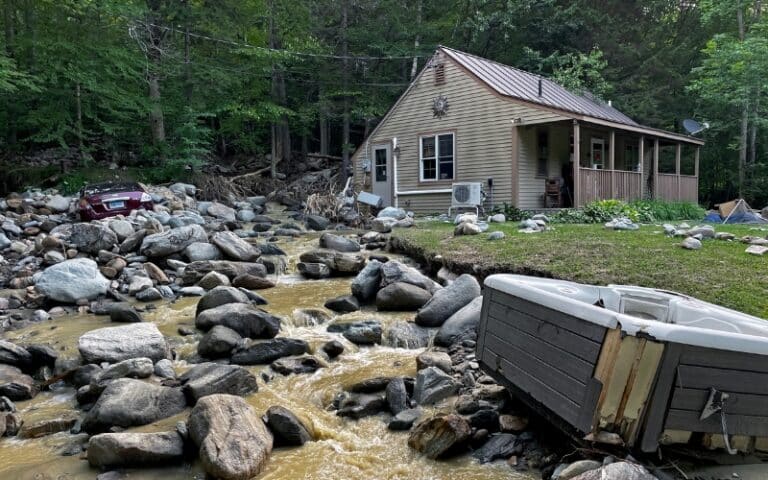ASFPM’s Detailed Priorities for FY2023 NFIP Reauthorization and Reform

The National Flood Insurance Program’s authority to provide flood insurance is set to expire on Sept. 30, 2023. The program’s last multi-year reauthorization was in 2017, and since that time, the program has experienced 25 short-term extensions and three brief lapses.
In our continued efforts to push for significant reform and long-term NFIP reauthorization, ASFPM has put together a detailed priority list of changes we’d like to see in the federal flood insurance program. The priorities address key components of the program, such as flood risk mapping, flood insurance, floodplain management, and flood mitigation, and the changes that ASFPM feels are necessary to strengthen the NFIP and advance equitable flood risk management across that nation.
The priorities are outlined below, or you can download the six-page fact sheet.
FLOOD RISK MAPPING
Reauthorize, fund and enhance the National Flood Mapping Program
- Reauthorize program and increase funding to a level that will enable the completion of the national mapping effort, as specified in the 2012 Biggert-Waters reauthorization, and help ensure all communities have modern, accurate and updated flood map data. An authorization of at least $800 million per year is critical to substantially map all riverine and coastal flood areas in the nation, while incorporating the additional mapping tasks required in BW-12 within five years:
- expedite the completion of flood mapping for every community in the United States by 2028 to get accurate flood mapping in place ahead of development and taxpayer investment in infrastructure.
- prioritize the elimination of the paper map inventory through conversion to digital format and provide technical assistance to disadvantaged communities to achieve equity
- require all A-zones to be model based with updated topography, and;
- prohibit digital conversion of flood maps unless a new engineering model backed study is conducted.
- Mapping effort must ensure inclusion of all the BW-12 NFIP floodplain mapping requirements are shown as layers on the digital maps:
- utilize future condition projections of relative sea-level rise, increased storm frequency and intensity, updated and future-expected precipitation and projections of future development;
- map all populated areas and areas of possible population growth located within the 100-year and 500-year floodplains and provide analysis and data for the 10-, 25-, 50-year events;
- map areas of residual risk, including areas that are protected by levees, dams, and other flood control structures, ensuring this information is publicly accessible; and
- identify the level of protection provided by flood control structures.
- Transition to a new national “floodway” standard that is based on a no adverse impact approach that doesn’t exacerbate future flood conditions, more fully preserves flood conveyance (half of the floodway is lost using the current one-foot rise and developed as flood fringe), recognizes and protects higher state floodway standards, and withstands judicial scrutiny.
- Promote integration of floodplain and wetland (natural resources) mapping.
- FEMA must coordinate with other federal agencies to:
- prioritize the completion of high-quality, nationwide topography (3-DEP) to accurately depict flood-hazard areas;
- update precipitation data used in flood studies (Atlas 14 at least every five years on a nation-wide basis and include future conditions scenarios; and
- expand and improve the stream gage and tidal gage networks.
- Address pluvial flood mapping by supporting pilot mapping efforts at the regional and local level, as well as supporting additional research and studies as to how to best identify and communicate pluvial flood risk.
- Authorize the Cooperating Technical Partners program in statute in recognition of its longtime successful approach to addressing community flood mapping concerns.
- Evaluate the need for additional flood risk zones to reflect new mapping scenarios.
FLOODPLAIN MANAGEMENT
Update and enhance the floodplain management program to provide states and communities the tools necessary to address and reduce flood risk
- Update the NFIP regulations and standards, including public input from the FEMA 2021 Request for Information, as per the ASFPM/NRDC petition for rulemaking. At a minimum, changes should include:
- adopting much more stringent standards for subdivisions and land use to avoid increased development in the SFHA and prohibition of critical actions where possible;
- requiring minimum freeboard of 2 feet (or 3’ for coastal areas or critical actions) above base flood elevation;
- extending the special flood hazard area to include the flood hazard areas determined by the required freeboard or climate informed science, and:
- providing changes that help eliminate the Severe Repetitive Loss (SRL) properties (including better SRL tracking, increasing ICC funding caps and funding availability).
- Enhance the Community Assistance Program
- Authorize the CAP-SSSE program in statute and increase the budget to $20 million annually to ensure support mechanisms for building capability at the state level to equitably and effectively help communities manage and mitigate their flood risk.
- Continue working with FEMA to identify the needs and concerns of states as the CAP transformation (Tiered State Framework) is implemented, including increased administrative burdens.
- Enhance Community Rating System (CRS)
- Develop CRS incentives that benefit the community as well as policyholders.
- Change CRS credits to provide credit for activities that increase standards and discourage and avoid development in the SFHA.
- Distribute a portion of the CRS savings provided by premium discounts to the community to incentivize flood risk mitigation, in addition the policyholder savings.
- Incorporate appropriate recommendations for changes from the 2021 FEMA Request for Information on re-imagining the CRS program.
- Ensure the goals of EO 13690 (Federal Flood Risk Management Standard (FFRMS)) are incorporated into the NFIP reauthorization so that federal taxpayer assets and investments consider, plan for, and account for current and future flood risk.
- Ensure that NFIP regulations allow for, encourage, and support maximum inclusion of state/community higher standards.
- Enable flood disclosure and data sharing
- Ensure timely and efficient access to flood insurance claims data sharing as well as access for property owners, and potential and existing buyers and renters, and local and state floodplain and emergency managers, appropriate research entities, and risk/mitigation programs.
- Provide an exemption to the Privacy Act to allow access to certain claims and insurance-related data, including repetitive loss and claims information, yet still protects personally identifiable information of the property owner.
- Provide NFIP participating states a pathway to authorizing legislation to provide full flood-risk disclosure for all property transactions (purchase and rental agreements) prior to closing on sales or signing of rental contracts.
FLOOD INSURANCE
Ensure that the flood insurance program is readily available, financially stable, and accurately reflects the risks associated with a property:
- Adjust the requirements on private flood insurance to ensure it does not erode the nation’s comprehensive flood-risk management framework (NFIP) already in place, and that private insurance will provide similar services.
- Raise cap on policy limits and remove the $35,000 cap on emergency phase policies.
- Require an ‘equivalency fee’ (equal to federal policy fee) on all private flood insurance policies for base coverage to help pay for flood mapping and floodplain management (essential tools to help communities and states manage flood risk so private insurers remain viable).
- Explicitly require that private flood policies that are sold to meet the federal mandatory purchase requirement are sold only in NFIP participating communities.
- Direct FEMA to establish a repository for all flood insurance claims data for NFIP and private flood insurance that is shared with communities and states. Require that private-sector flood insurance providers share comparable policy data in the same frequency and detail as FEMA shares to the private sector and as FEMA makes available to states and local floodplain managers, and, Direct FEMA to establish a repository for all flood insurance claims data for NFIP and private flood insurance that is shared with communities and states.
- Eliminate “discretionary acceptance” for private flood insurance policies which allows lenders to decide whether to accept private policies—this is in direct conflict with existing statute.
- Ensure that consumers know the coverage limits and other differences between private flood insurance policies and NFIP policies by requiring private policies to include a summary of differences between NFIP and private policies.
- Continue to require that private flood policies have, at a minimum, comparable coverages and deductibles as NFIP policies, including a requirement to pay for mitigation similar to the Increased Cost of Compliance benefit.
- Require language in state insurance regulations to ensure private flood insurers report claims data to the appropriate state agency and communities so states and communities can identify and track substantial damage and repetitive loss properties.
- Ensure that the NFIP does not become the “insurance program of last resort/residual program,” resulting in having only the highest risk policies in the NFIP portfolio.
- Provide a provision of continuous coverage between private and NFIP policies only if an equivalency fee is imposed, private policies meet the mandatory purchase requirement, and are sold only in NFIP participating communities.
- Ensure flood insurance claims are adjusted and paid fairly and timely.
- Oppose any exemption of certain classes of buildings from mandatory purchase. However, flood insurance should not be required for any accessory building with a value less than the minimum deductible (currently ($1,000).
- Oppose exclusion of commercial buildings from flood insurance availability.
- Improve insurance agent training on flood insurance to include mandatory training and continuing education, such as a minimum four hours/year of such education for renewal of a property and casualty insurance license.
- Consider some limitation on the maximum number of insurance claims per property. This will help limit taxpayer exposure, but the limitations must be tied to an offer for mitigation assistance.
- Consider requiring that all property owners obtain and maintain flood insurance.
Address equity
- Implement a targeted, means-tested, affordability mechanism that does not create a new subsidy or cross-subsidy within the NFIP.
- Rather than providing subsidies to NFIP insurance, consider better ways to subsidize and support mitigation efforts by individual property owners and the community as a whole.
- Forgive the current NFIP debt and adopt some form of a “sufficiency standard” as an automatic long-term mechanism within the NFIP that ensures, after a certain threshold of catastrophic events, the debt will be paid by the U.S. Treasury. Among other things, the sufficiency standard would consider the reserve fund balance, utilization of reinsurance, and ability of the policy base at that time to repay.
- Eliminate the policy surcharge. If the policy surcharge remains, use the proceeds of the surcharges, imposed by the HFIAA 2014 legislation to support the Increased Cost of Compliance (ICC) program funding, to boost cost-effective mitigation and reduce losses to the National Flood Insurance Fund and taxpayer-funded disaster relief.
Support and enhance Increased Cost of Compliance
- Increase ICC limit to at least $90,000. This is needed to reflect substantial increases in building construction and mitigation costs over past decades.
- Require FEMA to modify current policies and fully implement all aspects of ICC already in statutes, within one year of this NFIP reform, including:
- require ICC claims to be paid in addition to the maximum claim limit under the standard NFIP policy;
- require ICC to be triggered by non-flood-related damage events, and;
- expand eligible items to be paid under ICC to be substantially similar to eligible items under the FEMA HMA grants, including cost of building acquisition and removal from high-risk areas.
Strengthen Risk Rating 2.0
- Implement a means-tested affordability component to Risk Rating 2.0.
- Adjust the policy declaration page to ensure transparency of loss and expense constants.
- Establish an independent expert National Flood Insurance Advisory Council which would be empowered to review the data and algorithms used in RR 2.0 without regard to proprietary data sets in order to advise FEMA on improvements to RR 2.0 so that insurance rates fairly and accurately reflect risk. Using that advice, adjust Risk Rating 2.0 methodology to better support the connection between insurance and flood risk management, encourage true mitigation, such as freeboard and utility elevations, and ensure consumers are aware of and covered for their true flood risk.
- Develop a rating engine that can immediately be accessed & used by trained floodplain managers to provide “what if” advice to communities and residents on how all mitigation measures, including higher development standards, will lower premium rates
- Develop a simplified rating engine that residents and property owners can use to estimate flood insurance rates when buying or building in or near flood hazard areas.
- Inform/educate consumers that the Flood Insurance Rate Maps (“FIRMs”) will no longer be used to set insurance rates, but will be used for in/out determinations and local floodplain regulation requirements. Consider renaming the FIRMs so it is understood that they are for regulation and not for insurance rating.
- Ensure previously made mitigation investments are equitably recognized under the new rating system with transparency in the data set.
MITIGATION
Emphasize the importance of mitigation in managing flood risk.
- Ensure that Stafford Act mitigation programs (BRIC and HMPG) support the flood loss reduction goals of all of the NFIP programs and priorities:
- Prioritize traditional mitigation activities to ensure structure buyouts, elevation, and acquisition and relocation are competitive, are fully considered, and are appropriately funded in the mitigation programs grant process.
- Extend 1206 funding from 6 to 24 months to increase mitigation opportunities; consistent with other programs
- Provide a larger state set aside in grant programs to foster local/state traditional mitigation activities.
- Enhance funding of advanced (before flood happens) mitigation planning for inevitable flooding.
- Support pre-disaster mitigation of at-risk structures, especially repetitive loss.
- Explore requiring annual flood mitigation assistance (FMA) funding requests to support mitigating 5% of the repetitive loss properties/year.
- Ensure FMA funding is available not just for FEMA declared repetitive loss properties, but also for high-at-risk properties that may not yet have suffered a serious loss or losses.
- Address equity and social justice issues by ensuring that FEMA mitigation programs, including FMA, allow for the full use and resources of the Uniform Relocation Act and that funding to address displacement or address other federal/state environmental laws do not count as costs under FEMA’s benefit-cost analysis (i.e. removal of asbestos siding on mitigated properties)
- Provide improvements to the FEMA mitigation programs to support and ensure state programs have the means and capacity to provide all communities the technical. assistance needed to apply for and administer mitigation projects and actions.
- Provide cost-share funding in the mitigation programs to increase state capability so states can assist their communities in mitigation.
- Future conditions must be considered in planning and designs for mitigation projects.
- Nonstructural and nature-based mitigation should receive equal footing with larger, traditional structural projects in all mitigation grants.
- Mitigation actions must better meet social/environmental justice and equity goals.
- Ensure that in state and local mitigation plans, the priorities will identify and address social and environmental equity concerns, and such data are considered in awarding mitigation funding.
- Reevaluate the use of traditional benefit-cost methodology as a criteria or decision tool for existing and future risk for mitigation projects. Loss of life and homes, social justice, health and safety, and ecosystem protection and restoration currently and in the future must be established as basic criteria in benefit-cost analysis. Technical assistance is needed for disadvantaged communities.
- Help more homeowners retrofit their homes to the growing threat of climate-related flooding through increased and more flexible NFIP-related funding.
- Explore options to get mitigation funding to property owners when a community may not have the capacity to apply for and administer grants (e.g. use and support states’ mitigation capabilities).
- Establish a pilot program to fund proactive buyout of undeveloped land. Better utilize non-profit entities for buyouts of open space by broadening the concept of beneficial use, e.g., allow NGOs to buy the land and sell, make available, or donate lands to the community.
- Enable use of a pre-flood acquisition process, which allows property owners to remain in their structure until the next flood or they decide to move out. Require FEMA to develop and execute a comprehensive repetitive loss strategy, including a requirement to go to full actuarial rates after a certain number of claims, unless a mitigation offer is accepted and used.



